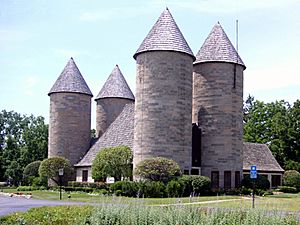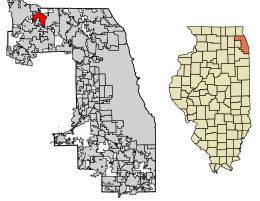Inverness, Illinois facts for kids
Quick facts for kids
Inverness, Illinois
|
|||
|---|---|---|---|

Inverness Village Hall
|
|||
|
|||
| Motto(s):
"The village with a heritage"
|
|||

Location of Inverness in Cook County, Illinois.
|
|||
| Country | United States | ||
| State | Illinois | ||
| County | Cook | ||
| Township | Palatine | ||
| Area | |||
| • Total | 6.69 sq mi (17.33 km2) | ||
| • Land | 6.53 sq mi (16.92 km2) | ||
| • Water | 0.15 sq mi (0.40 km2) | ||
| Population
(2020)
|
|||
| • Total | 7,616 | ||
| • Density | 1,165.60/sq mi (450.01/km2) | ||
| Time zone | UTC-6 (CST) | ||
| • Summer (DST) | UTC-5 (CDT) | ||
| ZIP Code(s) |
60067, 60010
|
||
| Area code(s) | 847 | ||
| FIPS code | 17-37608 | ||
Inverness is a quiet village located in Cook County, Illinois, in the United States. It's a suburban area, meaning it's a community near a larger city. According to the 2020 census, about 7,616 people live there.
Contents
Where is Inverness Located?
Inverness is found at 42°6′47″N 88°5′54″W / 42.11306°N 88.09833°W. This is its exact location on a map.
Size and Borders
The village covers a total area of about 6.69 square miles (17.33 square kilometers). Most of this area, about 6.53 square miles (16.92 square kilometers), is land. A smaller part, about 0.16 square miles (0.40 square kilometers), is water.
The edges of the village are clearly marked. Barrington Road is to the west, and Roselle Road is to the east. Algonquin Road forms the southern border, and Dundee Road is to the north.
A Brief History of Inverness
The area where Inverness now stands was first settled in 1836. A person named George Ela was one of the first to live there. It was known as Deer Grove back then.
Early Days and Railroads
In 1840, the U.S. government started selling land in the area. It cost $1.25 for each acre. By 1854, a train service reached Deer Grove. This train line later became part of the Chicago and North Western Railway system in 1859. This made it much easier for people to travel to and from Chicago. The area was now open for more people to settle.
How Inverness Got Its Name
In 1926, a famous land developer from Chicago, Mr. Arthur T. McIntosh, bought a large farm. This was the first of many land purchases he made. He also bought the Cudahy Company Golf Course. All these lands together made up about 1,500 acres. McIntosh named this large area Inverness. He chose this name because it was the name of his family's home in Scotland.
Developing the Village
An important person in the early development of Inverness was Way Thompson. He helped keep the natural beauty of the area. He designed the roads to follow the natural hills and curves of the land. He also made sure that each building lot was at least one acre in size. This helped keep the area feeling open and natural.
Thompson also had to approve all house plans. He even decided where each house would be built on its lot. The first ten homes were even decorated by his wife, Barbara. The first new homes were ready by 1939. These homes were often built around the Inverness Golf Club. They were designed to be affordable for young couples.
Growth and Village Government
Building in Inverness stopped during World War II. After the war, the McIntosh Company carefully managed how lots were sold. They also controlled the resale of homes. This helped keep the community's special character.
In 1962, Inverness officially became a village. It would be run by a president and a board of trustees. Their first meeting was on July 5, 1962. The Village Hall, where the government offices are, moved a few times. In 1985, it moved to its current spot at the Four Silos. This building has become a well-known landmark for the community.
During the 1970s and 1980s, Inverness continued to grow. Homes became larger and came in many different styles. The village also added more areas of homes that were not officially part of any town before. This helped Inverness expand to its current size. Williamsburg Village, the only business area in Inverness, started in 1981.
Inverness Population and People
| Historical population | |||
|---|---|---|---|
| Census | Pop. | %± | |
| 1970 | 1,674 | — | |
| 1980 | 4,046 | 141.7% | |
| 1990 | 6,503 | 60.7% | |
| 2000 | 6,749 | 3.8% | |
| 2010 | 7,399 | 9.6% | |
| 2020 | 7,616 | 2.9% | |
| U.S. Decennial Census 2010 2020 |
|||
In 2020, the village of Inverness had 7,616 people living there. There were 2,842 households, which are groups of people living together. Most of these, 2,300, were families.
Who Lives in Inverness?
About 78% of the people in Inverness are White. About 16% are Asian, and a small number are African American or Native American. About 3.4% of the population is Hispanic or Latino.
Many households, about 32.8%, have children under 18 living with them. Most households, 74.3%, are married couples. About 11% of households have someone living alone who is 65 or older. The average household size is about 3 people.
Age and Income
The people in Inverness have different ages. About 21.7% are under 18 years old. About 26.7% are 65 years or older. The average age in the village is about 52.6 years.
The median income for a household in Inverness was about $185,558. This means half of the households earned more than this amount, and half earned less. For families, the median income was even higher, at $204,056. A very small number of people, about 2.6%, live below the poverty line.
| Race / Ethnicity (NH = Non-Hispanic) | Pop 2000 | Pop 2010 | Pop 2020 | % 2000 | % 2010 | % 2020 |
|---|---|---|---|---|---|---|
| White alone (NH) | 6,110 | 6,249 | 5,867 | 90.53% | 84.46% | 77.04% |
| Black or African American alone (NH) | 45 | 36 | 39 | 0.67% | 0.49% | 0.51% |
| Native American or Alaska Native alone (NH) | 6 | 0 | 1 | 0.09% | 0.00% | 0.01% |
| Asian alone (NH) | 420 | 828 | 1,207 | 6.22% | 11.19% | 15.85% |
| Pacific Islander alone (NH) | 6 | 3 | 3 | 0.09% | 0.04% | 0.04% |
| Other race alone (NH) | 7 | 2 | 32 | 0.10% | 0.03% | 0.42% |
| Mixed race or Multiracial (NH) | 27 | 103 | 205 | 0.40% | 1.39% | 2.69% |
| Hispanic or Latino (any race) | 128 | 178 | 262 | 1.90% | 2.41% | 3.44% |
| Total | 6,749 | 7,399 | 7,616 | 100.00% | 100.00% | 100.00% |
Schools in Inverness
Public schools in Inverness are managed by two different school districts. These are Barrington District 220 and School District 15. Students also attend Township High School District 211.
Inverness is also home to a private school called Holy Family Catholic Academy. This school was started in 2002. It is a Catholic school that is part of the Roman Catholic Archdiocese of Chicago. About 300 students attend Holy Family Catholic Academy, from pre-kindergarten up to 8th grade.
See also
 In Spanish: Inverness (Illinois) para niños
In Spanish: Inverness (Illinois) para niños






